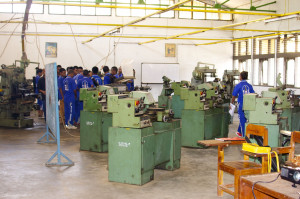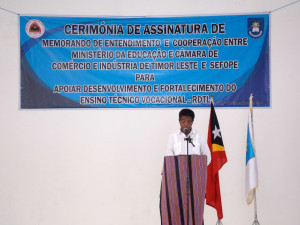Expansion of Secondary Technical-Vocational Education in Timor-Leste

On September 6th, 2016, the Minister of State, Coordinator of Social Affairs and Minister of Education presented a summary of statistical data on the policies and ongoing activities related to Secondary Technical-Vocational Education (STVE).
According to the general data on Secondary Education for the 2016 school year, there are 7,938 students and 771 teachers in the 32 private and public STVE schools of Timor-Leste. The two largest cities in the country, Dili and Baucau, have the most secondary schools, and the difference in the number of educational institutions dedicated to STVE is little, with Baucau having five schools and the capital seven.
Secondary Education in Timor-Leste is divided into general secondary schools and technical secondary schools. General Secondary Education (GSE) aims to prepare students to continue their studies in Higher Education, while Technical Secondary Education is designed to allow students to gain earlier entry into the labour market, with technical skills related to professional practices, while still enabling students to access higher education.
The differences between the two approaches is clear in the Education Strategic Plan for 2011-2030, where the objectives for a future balance of student distribution are presented. The target set for 2015 was achieved, with a total of 7,416 students enrolled in STVE, accounting for 14% of the total number of students in secondary education. It should be noted that, between 2012 and 2016, this percentage was only 12% to 14%, which placed the vast majority of the students in the General Secondary Education. 
The number of schools and students undertaking STVE remains much lower than the number of schools and students in the General Secondary Education. It is expected that the expansion of the number of Technical Secondary Schools will include the conversion of approximately 12 schools from GSE, increasing the capacity of schools already in existence and the creation of new educational institutions.
Regarding teachers, in 2016 the National Directorate of Secondary Technical-Vocational Education considered that staffing levels were adequate to cope with the number of students and classes. However, in order to improve the results of the learning process, there is a need for modernizing specialized training with conditions that are technologically more advanced.
 In order to create and strengthen the connection between the STVE and the labour market, measures were taken at the level of the courses’ curriculum, the creation of school training manuals, training in a working context, assessment of professional skills, in agreements with the Secretary of State for Employment Policy and Vocational Training (SEFOPE in Portuguese) and with the Chamber of Commerce and Industry (CCI in Portuguese). The creation of School Cooperatives and plans to conduct a School Fair are also in progress.
In order to create and strengthen the connection between the STVE and the labour market, measures were taken at the level of the courses’ curriculum, the creation of school training manuals, training in a working context, assessment of professional skills, in agreements with the Secretary of State for Employment Policy and Vocational Training (SEFOPE in Portuguese) and with the Chamber of Commerce and Industry (CCI in Portuguese). The creation of School Cooperatives and plans to conduct a School Fair are also in progress.
Taking into account the economic and social challenges that the country faces, particularly at the level of the technical qualifications of its citizens, and considering the needs of the country in several professional specialties, Secondary Technical-Vocational Education will satisfy a more demanding labour market and support more satisfactory remuneration and conditions for workers.










































